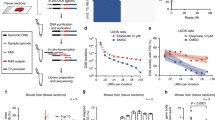Abstract
Molecular approaches are required to detect DNA double-strand break (DSB) events and to map and quantify them at high resolution. One of the most popular molecular methods in the field of meiotic recombination is the ChIP-SSDS (Chromatin immuno-precipitation and single-strand DNA sequencing). Here, we present two fully-automated Nextflow-based pipelines to analyze the sequencing data generated by this method. The first one identifies highly reproducible DSB sites, while the second provides a characterization of recovered DSB sites, including the description of the hotspot distribution and intensity along the genome and the overlap with specific regions such as gene features or known DSB hotspots. Finally, we discuss limitations/advantages and key points to consider when applying this method to specific genotypes or unconventional species.
Access this chapter
Tax calculation will be finalised at checkout
Purchases are for personal use only
Similar content being viewed by others
References
Smagulova F, Gregoretti IV, Brick K et al (2011) Genome-wide analysis reveals novel molecular features of mouse recombination hotspots. Nature 472:375–378
Mirzazadeh R, Kallas T, Bienko M et al (2018) Genome-wide profiling of DNA double-strand breaks by the BLESS and BLISS methods. In: Muzi-Falconi M, Brown GW (eds) Genome instability: methods and protocols. Springer, New York, pp 167–194
Yan WX, Mirzazadeh R, Garnerone S et al (2017) BLISS is a versatile and quantitative method for genome-wide profiling of DNA double-strand breaks. Nat Commun 8:15058
Biernacka A, Skrzypczak M, Zhu Y et al (2020) High-resolution, ultrasensitive and quantitative DNA double-strand break labeling in eukaryotic cells using i-BLESS. Nat Protoc 16:1034
Wong N, John S, Nussenzweig A et al (2021) END-seq: an unbiased, high-resolution, and genome-wide approach to map DNA double-strand breaks and resection in human cells. In: Methods in molecular biology – homologous recombination: methods and protocols
Canela A, Sridharan S, Sciascia N et al (2016) DNA breaks and end resection measured genome-wide by end sequencing. Mol Cell 63:898–911
Mimitou EP, Yamada S, Keeney S (2017) A global view of meiotic double-strand break end resection. Science 355:40–45
Lange J, Yamada S, Tischfield SE et al (2016) The landscape of mouse meiotic double-strand break formation, processing, and repair. Cell 167:1–14
Khil PP, Smagulova F, Brick KM et al (2012) Sensitive mapping of recombination hotspots using sequencing-based detection of ssDNA. Genome Res 22:957–965
Brick K, Pratto F, Sun CY et al (2018) Analysis of meiotic double-strand break initiation in mammals. Methods in Enzymology 601. Elsevier.
Hinch AG, Becker PW, Li T et al (2020) The configuration of RPA, RAD51, and DMC1 binding in Meiosis reveals the nature of critical recombination intermediates. Mol Cell 79:689–701.e10
Brick K (2019) SSDSnextflowPipeline [Source code]. https://github.com/kevbrick/SSDSpipeline
Brick K (2020) callSSDSpeaks [Source code]. https://github.com/kevbrick/callSSDSpeaks
Di Tommaso P, Chatzou M, Floden EW et al (2017) Nextflow enables reproducible computational workflows. Nat Biotechnol 35:316–319
nextflow-io (2017) Nextflow [Source code]. https://github.com/nextflow-io/nextflow/
Di Tommaso P Nextflow documentation. https://www.nextflow.io/docs/latest/index.html
Conda package manager. https://anaconda.org/bioconda/nextflow
Docker, https://www.docker.com/
Singularity, https://sylabs.io/
git, https://git-scm.com/
Nore A, Juarez-Martinez AB, Clément JAJ et al (2022) TOPOVIBL-REC114 interaction regulates meiotic DNA double-strand breaks. Nat Commun 13:1–19
Davies AB, Hatton E, Altemose N et al (2016) Re-engineering the zinc fingers of PRDM9 reverses hybrid sterility in mice. Nature 530:171–176
Papanikos F, Clément JAJ, Testa E et al (2019) Mouse ANKRD31 regulates spatiotemporal patterning of meiotic recombination initiation and ensures recombination between X and Y sex chromosomes. Mol Cell 74:1069–1085.e11
Acknowledgments
We thank Cyril Noël and Alizée Bardon (SeBiMER, Ifremer, Plouzané) for their help regarding Singularity images building. The authors acknowledge the bioinformatic service of IGH for providing computational resources for the early developments and the Pôle de Calcul et de Données Marines (PCDM; http://www.ifremer.fr/pcdm) for providing DATARMOR computational resources on which hotSSDS and hotSSDS-extra pipelines development have been completed.
We also thank Paola Sanna, Akbar Zainu, Mathilde Biot, Frédéric Baudat, Corinne Grey (de Massy team) and Miao Tian (Mochizuki team) from IGH for their feedback on the pipeline and their critical tests; Attila Toth, Arkasarathi Gope, Andreas Petzold, and Christin Richter from TU Dresden for their tests and helpful comments.
BdM was funded by ERC (European Research Council (ERC) Executive Agency under the European Union’s Horizon 2020 research and innovation program (Grant Agreement no. 883605)) and MSD Avenir.
Author information
Authors and Affiliations
Corresponding author
Editor information
Editors and Affiliations
Rights and permissions
Copyright information
© 2024 The Author(s), under exclusive license to Springer Science+Business Media, LLC, part of Springer Nature
About this protocol
Cite this protocol
Auffret, P., de Massy, B., Clément, J.A.J. (2024). Mapping Meiotic DNA Breaks: Two Fully-Automated Pipelines to Analyze Single-Strand DNA Sequencing Data, hotSSDS and hotSSDS-extra. In: Barchi, M., De Felici, M. (eds) Germ Cell Development. Methods in Molecular Biology, vol 2770. Humana, New York, NY. https://doi.org/10.1007/978-1-0716-3698-5_16
Download citation
DOI: https://doi.org/10.1007/978-1-0716-3698-5_16
Published:
Publisher Name: Humana, New York, NY
Print ISBN: 978-1-0716-3697-8
Online ISBN: 978-1-0716-3698-5
eBook Packages: Springer Protocols




